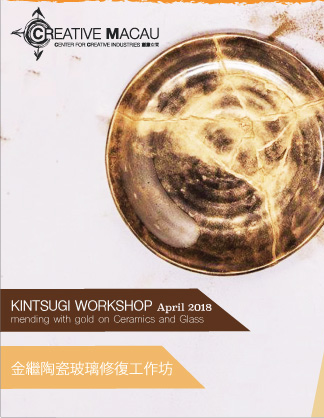Kintsugi or literally golden joinery repair is the Japanese art of repairing broken pottery with lacquer dusted or covered with powdered gold, silver, or platinum. It is the art of embracing damage as a philosophy, it treats breakage and repair as part of the history of an object, rather than something to disguise.
As this ancient technic developed it became a form of art for itself. Because of the delicate and meticulous technic, or because philosophical concepts apply to its basics that repair ads history and beauty to an object, it also applies to one’s life itself.
In this course, participants will bring a broken vessel to mend or join with Japanese lacquer, and covering it finally with gold and silver powder or leaf.
Attendants must bring their own broken or damage objects to mend or a new one to alter.
Kintsugi technique also can be applied to an undamaged object, therefore that may be transformed into a new design pattern as a piece of art.
Language: English, Portuguese, Japanese
Classes Schedules
basic, day class 9th, 11th, 12th, from 14:30 to 17:30 | Saturday 14th from 9:30 to 12:30
intermediate, night class 9th, 11th, 13th, from 18:30 to 21:30 | Saturday 14th from 14:30 to 17:30
day 1
Slide show
Introduction to Japanese lacquer Urushi: Applications, possibilities, and restrictions. Introduction talk for beginners and advanced classes in kintsugi techniques and basic and advanced concepts of Japanese lacquer techniques
Discussion about Japanese lacquer Urushi: New applications on porcelain, possibilities, and restrictions. Focus on attention to details and issues of resistance and durability of the natural urushi lacquer.
Personal projects discussion and prepare personal objects for mending.
Start mending personal objects* it will be basic or detailed depending on the attendants level.
1. Study the pieces to evaluate the damages and decide carefully the amount of intervention with glues and lacquer. Antiques, casual daily use items, emotional valued items, and items to transform with creative proposes have different issues to considered and approaches to repair. This phase is very important as these decisions will become aesthetically very much also a part of the repaired piece.
2. cleaning and preparing the pieces and start the first joining.
This joining will be the ‘’scar’’ that will be later covered with gold silver or red urushi lacquer. This phase is the most important as will decide the final shape that your piece will be stand like. Be aware that works with many small parts are difficult to joint in a sole class. Please avoid very complex damaged pieces, as you should only be able to joint 3 or 4 pieces at maximum , per class, for a better result in structural issues.
3. prepare the pieces to harden in a paper box with a hot and humid environment. Please bring a paper or carton box , that covers your piece completely , (big enough for not touching it) and a hand towel to wet and keep the inside of the box moisturized.That box, will be your little ‘‘sauna’‘or ‘‘muro’’ to keep and protect your work until the end of the course.
day 2
1. Continuing fixing the joints.
2. Prepare the works for hardening in their respective sauna boxes or “muro”
day 3
1. Finish and polish the mending areas with sandpaper, and cutters. This phase will be very important as will decide how detailed or perfect you can get for the final appearance of your work. Here as lacquer or epoxy resins harden you will scratch the excess and polish the areas fixed for the final application of the gold, silver or red lacquer.
day 4
1.Final polishing. Covering with fine lines the previous ‘‘scar’’ or mended areas with lacquer. Finally apply the gold or silver powder, or leaf, and design the final composition.
As works are still to dry and harden please use the ‘‘muro’’ box to carefully transport your piece after the end of the course.
